论文写作abstract
- 格式:pdf
- 大小:661.57 KB
- 文档页数:11
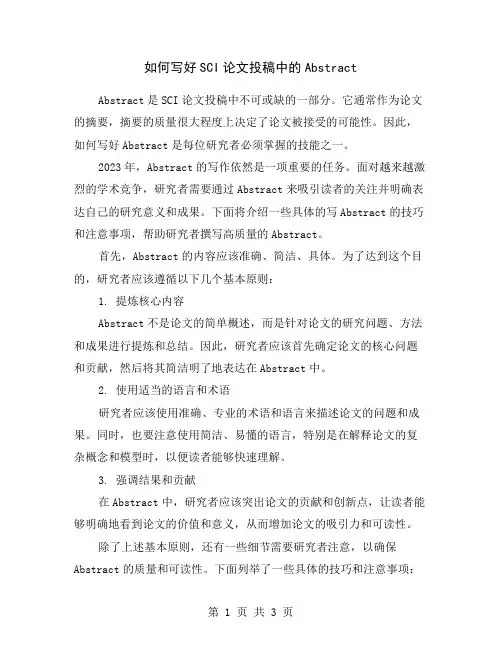
如何写好SCI论文投稿中的Abstract Abstract是SCI论文投稿中不可或缺的一部分。
它通常作为论文的摘要,摘要的质量很大程度上决定了论文被接受的可能性。
因此,如何写好Abstract是每位研究者必须掌握的技能之一。
2023年,Abstract的写作依然是一项重要的任务。
面对越来越激烈的学术竞争,研究者需要通过Abstract来吸引读者的关注并明确表达自己的研究意义和成果。
下面将介绍一些具体的写Abstract的技巧和注意事项,帮助研究者撰写高质量的Abstract。
首先,Abstract的内容应该准确、简洁、具体。
为了达到这个目的,研究者应该遵循以下几个基本原则:1. 提炼核心内容Abstract不是论文的简单概述,而是针对论文的研究问题、方法和成果进行提炼和总结。
因此,研究者应该首先确定论文的核心问题和贡献,然后将其简洁明了地表达在Abstract中。
2. 使用适当的语言和术语研究者应该使用准确、专业的术语和语言来描述论文的问题和成果。
同时,也要注意使用简洁、易懂的语言,特别是在解释论文的复杂概念和模型时,以便读者能够快速理解。
3. 强调结果和贡献在Abstract中,研究者应该突出论文的贡献和创新点,让读者能够明确地看到论文的价值和意义,从而增加论文的吸引力和可读性。
除了上述基本原则,还有一些细节需要研究者注意,以确保Abstract的质量和可读性。
下面列举了一些具体的技巧和注意事项:1. 遵循SCI期刊的写作规范Abstract的格式和内容要符合SCI期刊的要求,这包括使用适当的字体、字号、行间距、段间距,以及指定Abstract的篇幅等。
研究者应该仔细阅读SCI期刊的投稿说明,确保自己的Abstract符合要求。
2. 遵循逻辑顺序和结构研究者应该遵循逻辑顺序和结构来组织Abstract的内容。
通常来说,Abstract应该包括论文的研究问题、研究方法、主要结果、贡献和意义等。
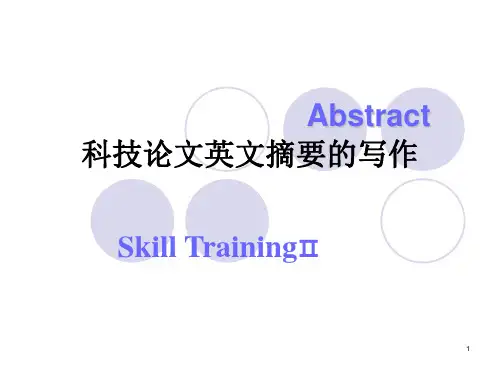
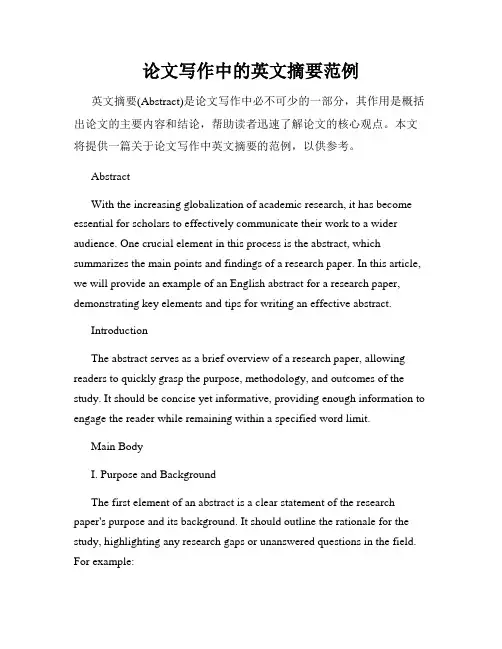
论文写作中的英文摘要范例英文摘要(Abstract)是论文写作中必不可少的一部分,其作用是概括出论文的主要内容和结论,帮助读者迅速了解论文的核心观点。
本文将提供一篇关于论文写作中英文摘要的范例,以供参考。
AbstractWith the increasing globalization of academic research, it has become essential for scholars to effectively communicate their work to a wider audience. One crucial element in this process is the abstract, which summarizes the main points and findings of a research paper. In this article, we will provide an example of an English abstract for a research paper, demonstrating key elements and tips for writing an effective abstract.IntroductionThe abstract serves as a brief overview of a research paper, allowing readers to quickly grasp the purpose, methodology, and outcomes of the study. It should be concise yet informative, providing enough information to engage the reader while remaining within a specified word limit.Main BodyI. Purpose and BackgroundThe first element of an abstract is a clear statement of the research paper's purpose and its background. It should outline the rationale for the study, highlighting any research gaps or unanswered questions in the field. For example:This research aims to investigate the effects of climate change on coastal ecosystems, with a focus on marine biodiversity and coral reef health. Given the increasing threats to these ecosystems, understanding the potential impacts of climate change is crucial for effective conservation strategies.II. MethodologyThe abstract should briefly describe the methodology employed in the research. This can include the study design, data collection methods, and analytical approaches. However, detailed technical information should be avoided. For example:A combination of field surveys, laboratory experiments, and statistical analyses were conducted to assess the long-term effects of temperature increase and ocean acidification on coral reefs. Data on species diversity, abundance, and health were collected from various reefs in the Caribbean region.III. ResultsThe abstract should highlight the key findings of the research. It should summarize the outcomes and conclusions derived from the data analysis. However, specific data or numerical results should be avoided, focusing instead on general trends and significant discoveries. For example:Our study revealed a significant decline in coral species diversity and overall health in response to increased water temperatures and ocean acidification. Furthermore, we found a decrease in the abundance of commercially important fish species, indicating potential impacts on local communities dependent on coral reef resources.IV. Implications and ConclusionThe abstract should conclude with a discussion of the broader implications of the research and its significance. It should provide a concise statement summarizing the main contributions of the study to the field and any recommendations for future research or policy implications. For example:These findings highlight the urgent need for immediate actions to mitigate the effects of climate change on coastal ecosystems. Implementing measures to reduce greenhouse gas emissions and establishing marine protected areas can help safeguard marine biodiversity and protect the livelihoods of communities dependent on coral reef resources.ConclusionIn conclusion, writing an effective English abstract is crucial for communicating the key points and contributions of a research paper. By providing a clear purpose, concise methodology, major findings, and broader implications, the abstract serves as a concise summary of the research work, enticing readers to delve deeper into the full paper. By following the guidelines and structure provided in this example abstract, researchers can enhance their chances of effectively conveying their research to a global audience.。
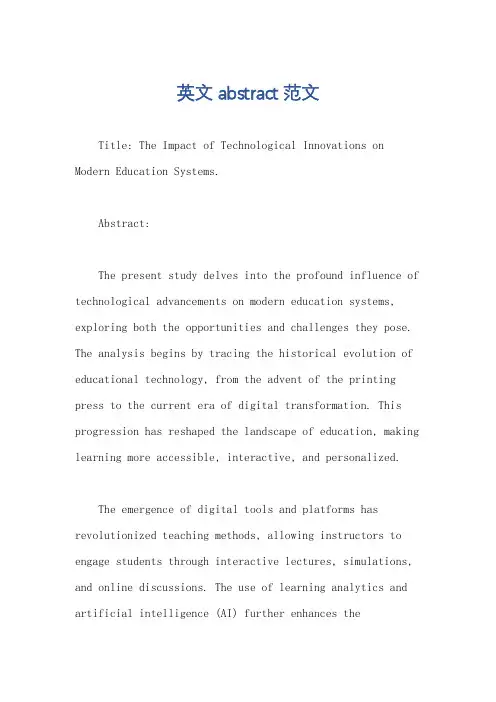
英文abstract范文Title: The Impact of Technological Innovations on Modern Education Systems.Abstract:The present study delves into the profound influence of technological advancements on modern education systems, exploring both the opportunities and challenges they pose. The analysis begins by tracing the historical evolution of educational technology, from the advent of the printing press to the current era of digital transformation. This progression has reshaped the landscape of education, making learning more accessible, interactive, and personalized.The emergence of digital tools and platforms has revolutionized teaching methods, allowing instructors to engage students through interactive lectures, simulations, and online discussions. The use of learning analytics and artificial intelligence (AI) further enhances thepersonalization of learning experiences, as they enable teachers to tailor their approaches to individual student needs and preferences. These technological advancements have also expanded the reach of education, breaking down geographical barriers and connecting learners from diverse backgrounds.However, the integration of technology into education systems has not been without its challenges. Onesignificant concern is the digital divide, which refers to the unequal access to technology and its associated resources among different social and economic groups. This divide can exacerbate existing educational disparities, limiting the potential of technological advancements to transform education for all.Moreover, the widespread use of digital tools raises concerns about privacy and security. The collection and analysis of personal data, while essential for personalized learning, must be balanced with the need to protect student privacy. Additionally, the ethical implications of AI-powered decision-making in education, such as automatedgrading and admissions processes, must be carefully considered.Despite these challenges, the potential of technological innovations to improve education systems remains significant. The future of education lies in harnessing the power of technology to create inclusive, equitable, and innovative learning environments that cater to the diverse needs of students. To achieve this, it is crucial to address the digital divide, prioritize data privacy and security, and ensure ethical implementation of AI and other emerging technologies.The present study contributes to the ongoing discussion about the role of technology in education by providing a comprehensive analysis of its impacts and implications. It offers insights into the opportunities and challenges presented by technological advancements, highlighting the need for a balanced approach that addresses both the potential benefits and risks associated with theintegration of technology into modern education systems.。
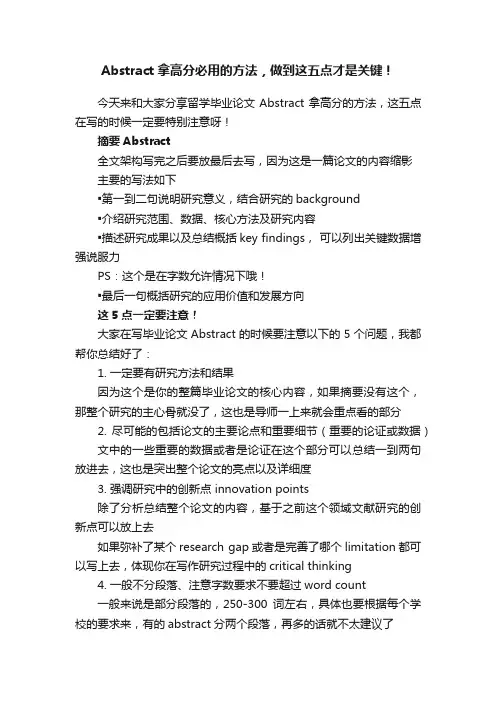
Abstract拿高分必用的方法,做到这五点才是关键!今天来和大家分享留学毕业论文Abstract拿高分的方法,这五点在写的时候一定要特别注意呀!摘要Abstract全文架构写完之后要放最后去写,因为这是一篇论文的内容缩影主要的写法如下▪️第一到二句说明研究意义,结合研究的background▪️介绍研究范围、数据、核心方法及研究内容▪️描述研究成果以及总结概括key findings,可以列出关键数据增强说服力PS:这个是在字数允许情况下哦!▪️最后一句概括研究的应用价值和发展方向这5点一定要注意!大家在写毕业论文Abstract的时候要注意以下的5个问题,我都帮你总结好了:1. 一定要有研究方法和结果因为这个是你的整篇毕业论文的核心内容,如果摘要没有这个,那整个研究的主心骨就没了,这也是导师一上来就会重点看的部分2. 尽可能的包括论文的主要论点和重要细节(重要的论证或数据)文中的一些重要的数据或者是论证在这个部分可以总结一到两句放进去,这也是突出整个论文的亮点以及详细度3. 强调研究中的创新点 innovation points除了分析总结整个论文的内容,基于之前这个领域文献研究的创新点可以放上去如果弥补了某个research gap或者是完善了哪个limitation都可以写上去,体现你在写作研究过程中的critical thinking4. 一般不分段落、注意字数要求不要超过word count一般来说是部分段落的,250-300词左右,具体也要根据每个学校的要求来,有的abstract分两个段落,再多的话就不太建议了5. 注意要采用规范化的名词术语、缩略语、代号、计量单位和标点符号等等Tips关于摘要下面的关键词:1、选出凸显文章学术贡献的词语作为关键词2、一般4-6个左右,根据每篇论文写的内容和具体导师的要求而定3、排列顺序按重要性大小。
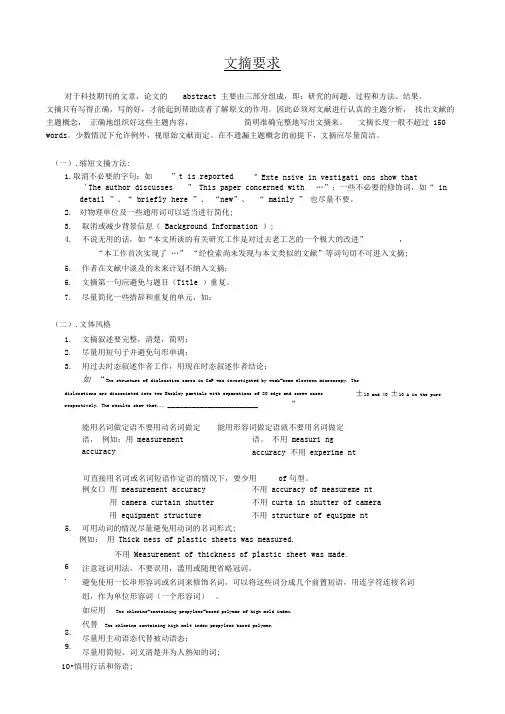
文摘要求对于科技期刊的文章,论文的 abstract 主要由三部分组成,即:研究的问题、过程和方法、结果。
文摘只有写得正确,写的好,才能起到帮助读者了解原文的作用。
因此必须对文献进行认真的主题分析, 找出文献的主题概念, 正确地组织好这些主题内容,简明准确完整地写出文摘来。
文摘长度一般不超过 150 words 。
少数情况下允许例外,视原始文献而定。
在不遗漏主题概念的前提下,文摘应尽量简洁。
(一).缩短文摘方法:1.取消不必要的字句:如 ”t is reported here ”、 “new ”、 “ mainly ” 也尽量不要。
2. 对物理单位及一些通用词可以适当进行简化;3. 取消或减少背景信息( Background Information );4. 不说无用的话,如“本文所谈的有关研究工作是对过去老工艺的一个极大的改进”, “本工作首次实现了 …” “经检索尚未发现与本文类似的文献”等词句切不可进入文摘;5. 作者在文献中谈及的未来计划不纳入文摘;6. 文摘第一句应避免与题目(Title )重复。
7. 尽量简化一些措辞和重复的单元,如:(二).文体风格 1. 文摘叙述要完整,清楚,简明;2. 尽量用短句子并避免句形单调;3. 用过去时态叙述作者工作,用现在时态叙述作者结论;如 “The structure of dislocation cores in GaP was investigated by weak-beam electron microscopy. Thedislocations are dissociated into two Shokley partials with separations of 80 edge and screw casesrespectively. The results show that... __________________________________ ”可直接用名词或名词短语作定语的情况下,要少用 of 句型。

SCI论文写作常用句式之AbstractAbstract摘要以最简洁的文字概括论文,点明研究的目的、途径、结果、意义,以便读者决定是否要阅读全文。
摘要一般包含几项内容:1. 论文主题(1句)2. 理论基础、途径、方法(1-2句)3. 研究结果(1句)4. 影响和价值(1句)1.论文主题In this paper, we present a … approach to …本文提出了一种针对,,的…方法。
In this paper, we describe improved … models for …本文介绍几种针对…的改进的…模型。
We propose a new … model and … algorithm that enables us to …我们提出一种新的…模型和…算法,它让我们能够…We present a … model that enables …我们提出了一种…模型,它使我们能够…This paper demonstrates the ability of … to perform robust and accurate …本文证明了…进行…可靠准确的…的能力。
In this paper we report results of a … approach to …本文报导了…的…方法的实验结果。
This paper demonstrates that … can effectively … with very high accuracy.本文证明,…能够有效地准确地…The purpose/goal/intention/objective/object/emphasis/aim of this paper is …本文的目的是…The primary/chief/overall/main object of this study is to survey …本研究的首要目标是考察…The chief aim of this paper/research/study/experiment/the present work is …本文的主要目标是…The emphasis of this study lies in …我们的研究重点是…The work presented in this paper focuses on …本文所述工作重点放在…Our goal has been to provide …我们的目标是提供…The main objective of our investigation has been to obtainsome knowledge of …我们的研究目标是获取有关…的知识。
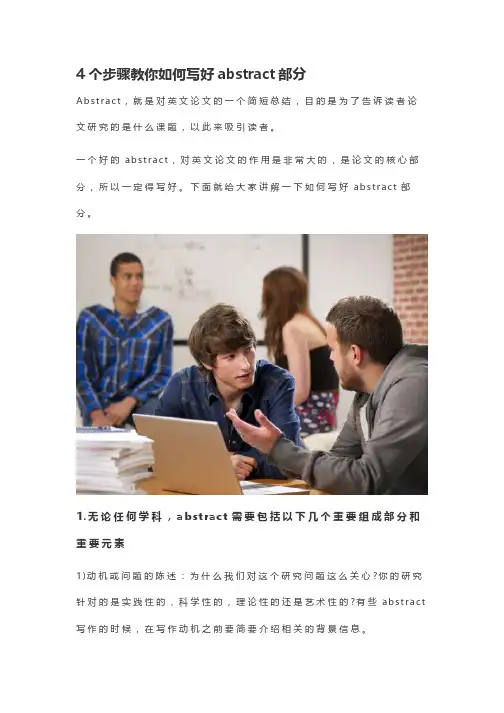
4个步骤教你如何写好abstract部分A b s t r a c t,就是对英文论文的一个简短总结,目的是为了告诉读者论文研究的是什么课题,以此来吸引读者。
一个好的a b s t r a c t,对英文论文的作用是非常大的,是论文的核心部分,所以一定得写好。
下面就给大家讲解一下如何写好a b s t r a c t部分。
1.无论任何学科,a b s t rac t需要包括以下几个重要组成部分和重要元素1)动机或问题的陈述:为什么我们对这个研究问题这么关心?你的研究针对的是实践性的,科学性的,理论性的还是艺术性的?有些a b s t r a c t 写作的时候,在写作动机之前要简要介绍相关的背景信息。
2)措施/流程/解决方法以及调查范围:为了得到相关的结果,你做了什么?3)结果/发现/产品:在上述的调查研究完成后,你学会了什么?发现了什么?创造了什么?4)结论/影响:你得出的哪些结论会产生更大的影响?然而,需要注意的是,根据不同的学科,要注意相关的可变性因素。
2.a b s t rac t中的语法特点和要求1)注意到细微的变化在陈述主要目标和调查范围的时候,多采用陈述性语言。
2)采用合适的方法描述方法的时候多使用过去时态。
要注意时态的一致性。
如果有必要,要按照时间的顺序进行排列。
3)注意结果的呈现方式只需要呈现结果即可。
以过去时态呈现出来。
4)注意结论的可靠性陈述个人观点。
在陈述主要结论的时候要使用现在时。
不要表现出试探性的倾向。
3.a b s t rac t s的类型a b s t r a c t s分为两种类型,i n f o r m a t i o n a l a b s t r a c t s和d e s c r i p t i v ea b s t r a c t s。
I n f o r m a t i o n a l A b s t r a c t s--针对r e p o r t s的相关内容进行沟通。
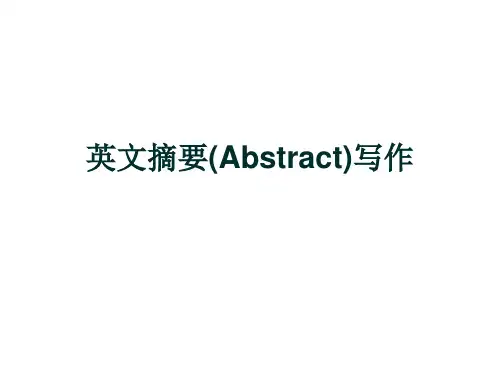
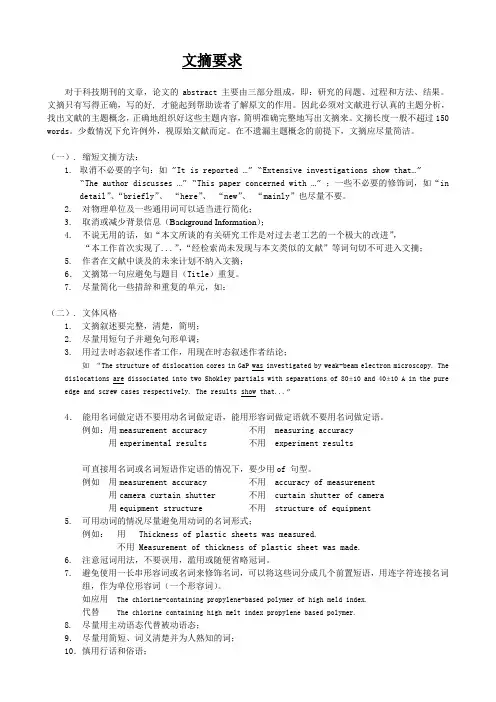
文摘要求对于科技期刊的文章,论文的abstract主要由三部分组成,即:研究的问题、过程和方法、结果。
文摘只有写得正确,写的好, 才能起到帮助读者了解原文的作用。
因此必须对文献进行认真的主题分析,找出文献的主题概念,正确地组织好这些主题内容,简明准确完整地写出文摘来。
文摘长度一般不超过150 words。
少数情况下允许例外,视原始文献而定。
在不遗漏主题概念的前提下,文摘应尽量简洁。
(一). 缩短文摘方法:1.取消不必要的字句:如”It is reported …”“Extensive investigations show that…”“The author discusses …”“This paper concerned with …”;一些不必要的修饰词,如“in detail”、“briefly”、“here”、“new”、“mainly”也尽量不要。
2. 对物理单位及一些通用词可以适当进行简化;3.取消或减少背景信息(Background Information);4.不说无用的话,如“本文所谈的有关研究工作是对过去老工艺的一个极大的改进”,“本工作首次实现了...”,“经检索尚未发现与本文类似的文献”等词句切不可进入文摘;5. 作者在文献中谈及的未来计划不纳入文摘;6.文摘第一句应避免与题目(Title)重复。
7. 尽量简化一些措辞和重复的单元,如:(二). 文体风格1. 文摘叙述要完整,清楚,简明;2. 尽量用短句子并避免句形单调;3. 用过去时态叙述作者工作,用现在时态叙述作者结论;如“The structure of dislocation cores in GaP was investigated by weak-beam electron microscopy. The dislocations are dissociated into two Shokley partials with separations of 80±10 and 40±10 A in the pure edge and screw cases respectively. The results show that...”4.能用名词做定语不要用动名词做定语,能用形容词做定语就不要用名词做定语。
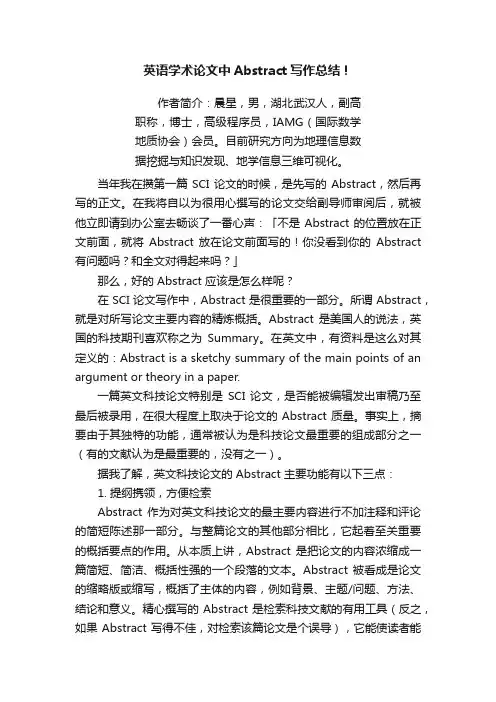
英语学术论文中Abstract写作总结!作者简介:晨星,男,湖北武汉人,副高职称,博士,高级程序员,IAMG(国际数学地质协会)会员。
目前研究方向为地理信息数据挖掘与知识发现、地学信息三维可视化。
当年我在攒第一篇 SCI 论文的时候,是先写的 Abstract,然后再写的正文。
在我将自以为很用心撰写的论文交给副导师审阅后,就被他立即请到办公室去畅谈了一番心声:「不是 Abstract 的位置放在正文前面,就将Abstract 放在论文前面写的!你没看到你的Abstract 有问题吗?和全文对得起来吗?」那么,好的 Abstract 应该是怎么样呢?在 SCI 论文写作中,Abstract 是很重要的一部分。
所谓 Abstract,就是对所写论文主要内容的精炼概括。
Abstract 是美国人的说法,英国的科技期刊喜欢称之为Summary。
在英文中,有资料是这么对其定义的:Abstract is a sketchy summary of the main points of an argument or theory in a paper.一篇英文科技论文特别是SCI 论文,是否能被编辑发出审稿乃至最后被录用,在很大程度上取决于论文的 Abstract 质量。
事实上,摘要由于其独特的功能,通常被认为是科技论文最重要的组成部分之一(有的文献认为是最重要的,没有之一)。
据我了解,英文科技论文的 Abstract 主要功能有以下三点:1. 提纲携领,方便检索Abstract 作为对英文科技论文的最主要内容进行不加注释和评论的简短陈述那一部分。
与整篇论文的其他部分相比,它起着至关重要的概括要点的作用。
从本质上讲,Abstract 是把论文的内容浓缩成一篇简短、简洁、概括性强的一个段落的文本。
Abstract 被看成是论文的缩略版或缩写,概括了主体的内容,例如背景、主题/问题、方法、结论和意义。
精心撰写的Abstract是检索科技文献的有用工具(反之,如果 Abstract 写得不佳,对检索该篇论文是个误导),它能使读者能够更快、更方便地识别论文的基本内容,确定论文与其个人兴趣相关性,并最终决定是否需要继续阅读整篇论文。
如何撰写高质量的Abstract Abstract是一篇学术论文或报告中的简要摘要,通常用于提供读者对全文内容的概述。
在科研领域,撰写一个高质量的Abstract 是非常重要的,因为它对读者是否继续阅读全文起着关键作用。
本文将介绍如何撰写高质量的Abstract,以确保其准确、简洁且具有吸引力。
一、选取合适的内容撰写Abstract的首要任务是从全文中选取最重要的内容,以便让读者能够迅速了解到论文或报告的核心信息。
在选取内容时,需要重点关注以下几个方面:1. 研究目的和背景:简要介绍研究的背景和目的,指出为什么这个研究问题是值得关注的。
2. 方法与设计:简要描述研究所采用的方法、实验设计或分析过程。
3. 结果和发现:重点概括研究的主要结果和发现,突出与研究目的相关的关键信息。
4. 结论和意义:简要总结研究所得到的结论,并突出其在学术或应用领域的意义和贡献。
二、保持简洁明了Abstract的长度通常有字数限制,一般在150-300个单词之间。
在有限的字数内,要尽可能地清晰明了地传达论文的核心内容。
以下几点可以帮助你保持Abstract的简洁性:1. 使用简练的语言:避免使用过于复杂或冗长的词汇和句子结构,用简单清晰的语言表达研究的关键信息。
2. 紧凑的句子:将每个句子控制在较短的长度,以确保句子的表达简练、清晰。
3. 省略不必要的细节:只关注论文的核心内容,不需要详细描述方法的细节或结果的具体数值。
三、准确传达关键信息在撰写Abstract时,需要确保传达出论文的关键信息,同时避免误导读者。
以下几点是需要注意的:1. 避免主观评价:Abstract应该是客观的,避免使用主观评价或个人观点,只传达事实和研究结果。
2. 不引用文献:Abstract中不应该引用任何文献或提供网址链接,以保持简洁性。
3. 突出贡献和结论:在Abstract的结尾部分,强调研究工作的主要贡献和对学术或实践的重要意义。
四、修订和修改写完Abstract后,应该进行仔细的修订和修改,确保语句通顺、无语法错误,并且准确传达论文的核心信息。
Writing: AbstractWHAT IS AN ABSTRACT1. The Definition of an Abstract1 ) the objectives and scope of investigation;2) the methods used;3) the most important results;4) conclusion or recommendation.2. Features of AbstractsBrevity Accuracy Specificity Objectivity Informativeness IndependencyCLASSIFICATION OF ABSTRACTS1.Indicative Abstractsrmative Abstractsrmative-indicative Abstracts4.Other Types of Abstracts 1) Critical Abstracts 2) Mini-abstractsFUNCTIONS OF ABSTRACTSA Screening Device of Documents: An abstract gives readers the idea of what the article is about.A Self-contained Text: We’ll know the information it contains, without seeing the article .A Helpful Preview: It "frames" the article and prepares the reader for the main points to come.To Facilitate Indexing: It will improve the chances of having it read by the right people.STYLISTIC FEATURES OF ABSTRACTS1. The Length of Abstracts1) In general, there is a 100-300 word limit to the number of words in an abstract.2) Do not confuse an abstract with a review. There should be no comment or evaluation.3) Give information only once.4) Do not repeat the information given in the title.5) Do not include any facts or ideas that are not in the text.6) For informative abstracts, include enough data to support the conclusions.7) If reference to procedure is essential, try to restrict it to identification of method or process.8) State results, conclusions, or findings in clear concise fashion.9) Organize the information in the way that is most useful to the reader. (a thesis-first abstract)2. Verbs and Tenses Used in Abstracts1) Active verbs: use active verbs rather than passive verbs.2) Present tense: background information, existing facts, what is in the paper and conclusion.3) Past tense /present perfect tense: completed research, methodology or major activities results.3. Words Used in Abstracts1) Avoid use of highly specialized words or abbreviations. Define unfamiliar words.2) Synthesize or rephrase the information into clear, concise statements.3) Avoid using jargon.4. Sentence Structures of Abstracts1) Use third person sentences.2) Use short sentences, but vary sentence structure.3) Use complete sentences.4) The first sentence should present the subject and scope of the report. The thesis or the writer's focus should be presented in the second sentence. The balance of the article is a summary of the important points of each section, including methods, procedures, results and conclusions.5) Good abstracts are sure to include a variety of pat phrases:a. Background Information (Research has shown... It has been proposed... Another proposed property... The search is on for... One of the promising new...)b. Statement of the Problem (The objective of the research is to prove / verify... The experiment was designed to determine...)e. Statement of Procedure (To investigate this .... A group of 10 specimens / subjects ... Measurementswere taken after... A second group was...)d. Conclusions (It was found that .... Results imply... This data suggests... In the experimental group... In the control group...)e. Relates the Experiment to the Words (This kind of research encourages the belief that... Similar to ...) HOW TO WRITE AN ABSTRACT (An abstract must be written last as it sums up the results)l) Locate the thesis statement, identify the main divisions of the document, find the main terms (key words) and statements in each section;2) Decide the degree of detail to include;3) Prepare a single paragraph including the crucial information gathered;4) Edit the draft, eliminate unnecessary background information, and reduce wordy phrases;5) Finally, revise the opening statement to emphasize the new information contained in the paper.Start out the abstract by telling exactly what you did and how you did it. Focus on the rationale and ideas of the study and why it is important in the first two sentences. In the next few lines, focus on the materials and methods, and the data generated from the study. Tell the reader how the data were collected, compiled, and state statistical significance(s). Mention any new tools developed.Avoid using bibliographic references in the abstract. However, if your article follows directly from a published work and is a major advance on that specific piece of work, do cite the paper in the abstract.The end of the abstract is just as important as the beginning. The concluding lines of the abstract should lead into the first paragraph of the introduction without repeating what has been said. State the implications of your studies to the field of scholarship in which you are working.1. How to Write Informative Abstracts1) An informative abstract should be orderly, succinct, and concrete, with the length of no mere than 10% of the essay.2) Plan to write an abstract that is in the first draft, note key facts, statistics, etc. on the organisms, materials and locations used.3) Do not include a statement of scope or a sentence like "this paper will look at .... ".4) Write selected details of the experimental methods, including the duration of the study, the treatments, methods and equipment used.5) Be sure to omit or condense lengthy examples, tables, and other supporting detail.6) Do not hedge or equivocate.7) Give the key results, with a description of them and some of the main figures and their statistical significance.8) Use active verbs such as "report", "propos ", and "analyze" rather than static verbs such as "is", "are" and "appears to be".9) Revise the draft into smooth, stand-alone prose; the abstract itself should be a mini-essay.10) Edit the revision. Be sure that the abstract is complete and accurate, with a brief note on the significance of the results.11) Double check that the abstract is written in the same voice as is the paper.2. How to Write Indicative Abstracts1) List the title of the research report after "Abstract of..." at the top of your page.2) Summarize the major thesis and supporting main ideas of the report without omitting any important ideas.3) Avoid wordiness and repetition.4) Condense source material in your own words, being careful not to directly borrow text. You should not use direct quotations in abstracts.5) Use good sentence structure, grammar, mechanics, and spelling.6) Adhere to the 100-word limit. (No fewer than 90, nor more than 110)3. How to write Abstracts for Engineering InformationBackground: A simple opening sentence or two ;Aims: One or two sentences giving the purpose, the development, the survey as well as the assignment and the scope of the research;Method(s): One or two sentences explaining what was done and what the principles, the theory, the condition, the objective, the techniques, the framework, the means, the equipment and the procedure, etc. used in the research are;Results: One or two sentences indicating the main findings, the result, the data, the relationship, the effect and the performance of the experiment and research;Conclusions: One sentence giving the most important consequence of the work, the results of the analysis, the research, the evaluation and the application, and the issues that are raised as well.4. How to Write Abstracts for DissertationsThere are two purposes in dissertation abstract writing: to inform your reader, and to market your product. Aside from the guidelines mentioned above, there are some others:1) a dissertation abstract should have three elements, and three elements alone:a. a section on the problem you examined;b. a section showing your method;c. a section showing your findings.2) you need not give the history of the problem, why you chose to study it, your philosophy, or your self-congratulatory but humble remarks about how your dissertation will change the world.3) be sure to use some key words for easy referencing, an accurate and specific summary of your findings, and as active a voice as you can muster.5. How to Write Abstracts for ConferencesIt is a competitive process, but one to be undertaken seriously.1) Look for "Call for Papers" notices.2) Title: The title should be informative and focused, indicating the problem, kind of data and your general approach.3) Make your abstract as brief as possible, within the word limit set by the "Call for Papers".4) Make sure to describe the general topic clearly.5) Try to make your abstract appeal to the concept for the conference as it is defined in the "Call for Papers".6) Describe your treatment of the topic, and how it relates to previous work on the same topic.7) Explain how you will justify your treatment, and quote crucial evidence.8) Consider your audience carefully. You are essentially writing a speech. Your sentence structures, use of specialized language and theories, etc., should take this into account. Also, in oral discourse, you might want to summarize and / or repeat ideas more often.6. How to Write Research Abstracts1)The purpose of a research abstract can be boiled down to providing the answers to the following questions:a. Why did you start?b. What did you do?c. What did you find?d. What does it mean?2) Title: Ideally about 10-12 words long, the title should include the scope of the investigation, the study design, and the goal. In general it is preferable to make the title a description of what was investigated. The title should be easy for the reader to understand and should not include jargon or 3) Introduction or Background: this should provide a brief context or explanation for doing the study, and state the aim of the study, and ideally should include a concise statement of the study' s hypothesis. A scientific study is "to find out whether it is true."4) Methods: In an abstract the description of the methods has to be concise, and much of the details of what was done must be omitted. However, in a few short sentences the reader can be given a good idea of the design of the study, the context in which it was done, and the types of patients or measurements that were included.5) Results: space is limited. Still, it is important to give the main results of the study not just in subjective terms but also in the form of the most important data. Do not include a table or figure unless it is necessary to convey your results.6) Conclusions: Keep your conclusions reasonable and supportable by the findings of your study.7) Follow the instructions7. Some Don'ts in Abstract Writing1) Do not commence with "this paper...", "this report..." or similar. It is better to write about the research. Similarly, do not explain the sections or parts of the paper.2) Avoid sentences that end in "... is described", "... is reported", "... is analyzed" or similar. These are simply too vague to be informative.3) Do not begin sentences with "it is suggested that...", "it is believed that... ", "it is felt that..." or similar, for the words can be omitted without damaging the essential message.4) Do not write in the first person. Not only should you avoid I, but also we , the author , the writer, etc., because the abstract should be about the research, not about the act of writing.5) Do not submit an abstract with the length exceeding the limit offered.6) Do not submit your abstract later than the given date.7) Do not write an imprecise abstract.SAMPLESSample 1:Microscopic characterization of a TiB2-carbon material composite:Raw materials and composite characterizationAbstract: Titanium diboride (TiB2) is a very attractive material for the aluminum industry, because it is readily wetted by molten aluminum and combines good physical properties (electrical conductivity), chemical (fairly resistant to dissolution by molten aluminum), and mechanical (wear resistance) properties.// In this article, both raw materials(anthracite, pitch, and TiB2powder) and TiB2-carbon composites (TCC) were characterized.//Inclusions of aluminosilicate and iron oxide types were found in the anthracity aggregates. X-ray diffraction (XRD) analysis allowed differentiation between two types of aggregates: stratified (L C=44 nm) and nonstratified (L C=15 nm). The principal impurity found in the TiB2 powder was TiCN and surface analysis of the particles revealed the presence of a contaminant layer composed of C, N, O, and Ti; the thickness of this layer varied from 5 to 15 nm.// Characterization of the TiB2particles in the composite showed important surface modifications compared to their initial state. Evidence seen on the particles’ surfaces showed that a TiC-(O traces) formed preferentially on the side of particles rather than on top surface. The thickness of this TiC-(O traces) layer was evaluated to 30 nm.TiB2碳基复合材料的微观特征:原材料和复合物特征硼化钛(TiB2)在制铝业中是一种很受欢迎的材料,由于它易于被熔融的铝润湿,而且具有好的物理性能(导电率),化学性能(很好地抵御被熔融的铝分解)和机械性能(耐磨性).在这篇文章中,讨论了原材料(无烟煤,沥青和TiB2粉末)及TiB2碳基复合材料(TCC)的特征.在无沿煤聚合体中发现了铝矽酸盐和铁的氧化物.由X 射线衍射分析(XRD)可得两种聚合物的区别:层积的(L C=44 nm)和未层积的(L C=15 nm). TiB2粉末中发现的主要杂质是TiCN,另外颗粒表面分析可见由C, N, O, 和Ti组成的污染层;这个污染层从长远来5直15 nm 不等.符合物中TiB2颗粒的特征表明了与初始状态相比而言很重要的表面修正.颗粒表面所见的迹象显示TiC-(O traces)优先在颗粒的边缘而不是顶表面形成.这个TiC-(O traces)层厚度据估计有30 nm.Sample 2:Establishing a knowledge management programme for competitive advantage in an enterprise Abstract: This article is concerned with the establishment of a knowledge management programme that will ensure sustainable competitive advantage within an enterprise//. The main problem under investigation is to assess the importance of knowledge management within an enterprise and to ascertain how it can ensure sustained competitive advantage in an enterprise.// An empirical survey was conducted in the Eskom Transmission Group, Johannesburg, South Africa to investigate understanding of the knowledge management concept amongst business leader, determine enablers and barriers to implement a knowledge management programme and to determine whether knowledge is seen as a source for competitive advantage.// It is suggested that enterprises should adopt a holistic and integrated approach when establishing such a programme. Broad recommendations for establishing a knowledge management programme that will be source of sustainable competitive advantage are proposed. 2001 Elsevier Science Ltd.为实现企业的竞争优势建立知识管理的程序这是一篇关于为确保企业持续性竞争优势建立知识管理程序的文章.调查的主要问题是评价企业中知识管理的重要性和确定知识管理怎样保证企业的持续性竞争优势.为了调查知识管理概念在商业领导者中的理解程度,确定实施知识经济管理程序的有利和不利因素以及确定是否知识被看作竞争优势的源泉,南美约翰内斯堡的埃斯克姆传播小组进行了一次实验性研究.文章建议在建立知识管理程序的时候,企业应该采用完整综合的方法.文章在作为持续性竞争优势源泉的知识管理程序的建立方面提出了狠多的建议.。
SCI论文Abstract应注意的几个问题SCI摘要应注意的问题:1. 结构式摘要的四个标题:英文摘要分为:指示型摘要、信息-指示型摘要、信息型摘要和结构式摘要。
结构式摘要:习惯上,目的、方法、结果和结论相应的英文常译成Objective、Methods、Results和Conclusions。
2.时态的用法:(1)Objective部分:通常用一个不定式短语来表达。
(2)Methods部分:因为都是过去做过的事情,故应采用一般过去时。
(3)Results部分:也都是过去得出的结果,应该用一般过去时表达。
(4)Conclusions部分:因为文章得出的结论是科学的、客观的,所以应该用一般现在时表达。
应该强调的是,SCI论文英文摘要中的过去时应为一般过去时。
在编辑实践中,常常有作者采用过去进行时、过去完成时等等其他的过去时态表达方法。
有的作者在Conclusions部分用过去时态,这不仅是时态错误的问题,重要的是会让读者对文章的科学性产生怀疑——难道文章的结论在文章发表时就已经失效了吗?时态问题不仅仅反映文章英文水平的高低,在很大程度上影响着文章的科学性。
3. 标点符号的用法:英文摘要的标点符号是英文摘要中最容易出错的地方,同时也是作者最容易忽视的地方。
中文和英文的标点符号用法有许多不同,具体表现在以下几个方面:许多中文的标点符号在英文中并不使用:(1)顿号(、):顿号在汉语中起分割句子中的并列成分的作用;英语中没有顿号,分割句中的并列成分多用逗号。
如:“The operation time, incidence of complications, weight, nutritional status of patients were compared between the two groups.” 注意:类似的情况下,最后一个逗号后可加and,这个逗号也可省略,如:“The operation time, incidence of complications, weight (,) and nutritional status of patients were compared between the two groups.”(2)书名号(《》):英文没有书名号,书名、报刊名用斜体或者下划线表示。
How to Write an Abstract一、什么是摘要Abstract?an abstract comprises one paragraph which describes the main content of a paper and appears at the very beginning of the paper.摘要是叙述文章主要内容的一个段落,并且位于文章的开头部分.摘要是以梗概形式呈现的一篇文章要点的总结,它强调了一篇文章所包含的重要的信息.它也可以帮助读者快速的了解到是否这篇文章是他们感兴趣的,是否他们需要来阅读整篇文章。
而且,国家或国际出版社的编辑通常通过浏览投稿文章的摘要来决定是否投稿人的文章是可以被录用的。
因此,对于学者和研究人员来说,写一份好的摘要至关重要。
二、写作Abstract的目的对于科技论文的摘要,Abstract的目的有以下几点:1.Introduce journal articles.rm readers about article`s content.3.Help readers decide whether or not to read article.4.Overview conference programs,abstract collections,and book chapters.三、学习写作Abstract的必要性1。
Helps you present complex information in a clear,concise manner。
2.Helps you read abstracts more effectively.3。
Helps you conduct research.4.Helps you write abstracts for future publications。
5.Helps you condense report information into a short format for database searches。
How to Write an Abstract for a Research PaperWANG YanSchool of International StudiesUIBEIssues to address:1What is an abstract?2Functions of an abstract3Structure of an abstract4Principles of abstract writing1. What is an abstract?☐An abstract is a condensed version of a longer piece of writing that highlights the major points covered, concisely describes the purpose and scope of the writing,and reviews the writing's contents inabbreviated form.⏹It is a concise and clear summary of acomplete research paper.⏹It tells the reader What you set out todo, and Why you did it,How you did it, What you found (recommendations).2. Functions of an abstract☐An abstract is used to communicate specific information from the article.☐It is aimed at introducing the subject to readers, who may then read the article to find out the author's results, conclusions, or recommendations.2. Functions of an abstract☐The practice of using key words in an abstract is vital because of today'selectronic information retrieval systems.⏹Titles and abstracts are filed electronically, andkey words are put in electronic storage.⏹When people search for information, they enterkey words related to the subject, and thecomputer prints out the titles of all the articlescontaining those key words.⏹An abstract must contain key words about whatis essential in an article so that someone elsecan retrieve information from it.3. Structure of an abstract☐The components of an abstract①Background Information②Subject Matter/Problem Statement③Purpose④Method (and Data)⑤Results / Findings⑥Conclusion / ImplicationsThe components of an abstract①Background information◆You may need to refer briefly to background toprovide a context.②Statement of the problem (subject matter):◆What problem(s) are you trying to solve?◆What is the author’s focus in this research?③Purpose of the research:◆What is the reason/purpose for doing this research?④Methods (approach and data):◆What is the main method used for the research?What is the theoretical framework?◆What is the subject scope? What data is analyzed?⑤Results (Findings):◆What did you find/invent/create?⑥Conclusion (Implications):◆What are the larger implications of your findings, esp.for the problem/gap identified in steps ①& ②?Exercise 1:A Sample Abstract(1) The dozens of studies on academic discourse carried out over the past 20 years have mostly focused on written academic prose or on academic lectures. (2) Other registers that may be more important for students adjusting to university life, such as textbooks, have received surprisingly little attention, and spoken registers such as study groups or on-campus service encounters have been virtually ignored. (3) To explain more fully the nature of the tasks that incoming international students encounter, this article undertakes a comprehensive linguistic description of the range of spoken and written registers at U.S. universities. (4) Specifically, the article describes a multidimensional analysis of register variation in the TOEFL 2000 Spoken and Written Academic Language Corpus. (5) The analysis shows that spoken registers are fundamentally different from written ones in university contexts, regardless of purpose. (6) Some of the register characterizations are particularly surprising. (7) The findings of this research may provide insights and have significant implications for pedagogy and further research.subject matter (1) The dozens of studies on academic discoursecarried out over the past 20 years have mostlyfocused on written academic prose or onacademic lectures.problem statement (2) Other registers that may be more important forstudents adjusting to university life, such astextbooks, have received surprisingly littleattention, and spoken registers such as studygroups or on-campus service encounters havebeen virtually ignored.background information(3) To explain more fully the nature of the tasks that incoming international students encounter, this article undertakes a comprehensive linguistic description of the range of spoken and written registers at U.S. universities.(4) Specifically, the article describes a multidimensional analysis of register variation in the TOEFL 2000 Spoken and Written Academic Language Corpus.purposemethod data(5) The analysis shows that spoken registers are fundamentally different from written ones in university contexts, regardless of purpose.(6) Some of the register characterizations are particularly surprising.(7) The findings of this research may provide insights and have significant implications for pedagogy and further research.findings implications Subject:written in the third person Length:short, usually 10% or less of the length of the original piece Audience:understandable to a wide audience Language:technical language of the discipline or profession Verbs:passive voice Tense:the present tense the past tense the present perfect tense 4. Principles of abstract writing4. Principles of abstract writing☐Requirements for the abstract of aBA thesis in UIBE⏹Length: 200-300 words⏹Key words: 3⏹One page of Chinese abstract and onepage of English abstractLanguage used in an abstract Background:(1) The dozens of studies on academicdiscourse carried out over the past 20years have mostly focused on writtenacademic prose or on academic lectures. (2) Other registers that may be moreimportant for students adjusting touniversity life, such as textbooks,have received surprisingly little attention, and spoken registers such as studygroups or on-campus service encountershave been virtually ignored.Language used in an abstract Background:☐Most studies in this field have addressed …☐In recent years, there has been an increasing interest in …☐… has received much attention in the field of …e.g.:As a newly developed interdisciplinary field of study, research on the development ofpragmatic competence is increasinglyattracting extensive academic interest.Purpose:(3) To explain more fully the nature of the tasks that incoming international students encounter, this article undertakes a comprehensive linguistic description ...This paperattempts to…The purpose of this paper is to …This paper isintended to…Language used in an abstract Language used in an abstract Purpose ☐The purpose/aim/objective/goal (of present study is/was to ☐The present study is /was designed/ devised/ intended to / aimed at ☐This study was performed/ conducted/ carried out/undertaken to ☐We aimed/sought to/attempted to e.g.:The aim of this study was to determine the protective function of …Methods:(4) Specifically, the article describes a multidimensional analysis of register variation...A …approach isused in this studyto examine.The study employsa … approach.Language used in an abstractMethods:☐Introduce the research process:⏹study, investigate, examine, discuss, analyze, emphasize, focus, explain☐Describe the research methods:⏹measure, estimate, calculate, test☐Introduce the uses or implications:⏹use, applyLanguage used in an abstract Results:(5) The analysis shows that spoken registers are fundamentally different from …(6) Some of the register characterizations are particularly surprising.It is found that …The resultsindicated that…The resultssuggest/show that …Language used in an abstract Results:☐Show the research results:⏹show, result, present, suggeste.g.:⏹Our results show that …⏹The results we obtained demonstrate that …⏹By means of informal mathematical arguments, simulations and a series of worked examples, we conclude that …Language used in an abstractConclusion/implications:(7) The findings of this research may provide insights and have significant implications for pedagogy and further research.It is suggested that …The paper suggests …It isrecommended that …It is concluded that …Language used in an abstract Conclusion/Implications:1) indicate the results:⏹These results suggest that …⏹These data confirm the presence of …2) support a point:⏹These results (do not) support the idea that …⏹These results fail to support the idea that …3) show uncertainty of an idea:⏹There is no evidence that …⏹It is likely/unlikely that …4) show significance of the findings:⏹be of great (some/little/no) clinical significance in …⏹It sheds light on future studies in this field.5) suggest further studies:⏹… remain to be further studied.⏹It remains to be proved that …Language used in an abstract Steps For Writing Effective Abstracts1.Reread your paper with the purpose of abstracting in mind. Look specifically for these main parts: purpose, methods, scope, results, conclusions, and recommendations.2.After you have finished rereading your paper, write a rough draft WITHOUT LOOKING BACK AT YOUR PAPER. Consider the main parts of the abstract listed in step 1. Do not merely copy key sentences from your paper.3.Revise your rough draft to correct weaknesses in organization and coherence, drop superfluous information, add important information originally left out, eliminate wordiness, and correct errors in grammar and mechanics.4.Carefully proofread your final copy.Four C's of Abstract Writing☐Complete—it covers the major parts of the project/case.☐Concise—it contains no excess wordiness or unnecessary information.☐Clear—it is readable, well organized, and not too jargon-laden.☐Cohesive—it flows smoothly between the parts.Qualities Of A Good AbstractAn effective abstract☐uses one or more well-developed paragraphs, which are unified, coherent, concise, and able tostand alone☐uses an introduction-body-conclusion structure in which the parts of the paper are discussed in order: purpose, methods, findings, conclusions☐follows strictly the chronology of the paper☐provides logical connections between materials included☐adds no new information but simply summarizes the research☐is intelligible to a wide audienceQualities Of A Good Abstract☐Accuracy —choose exact words for precise☐Specificity —be concrete☐Objectivity —succinctly summarize main points;☐Informativeness —what the research is about; how it was taken, what wasdiscovered☐Independency —must stand aloneSummary☐Writing an abstract is a sophisticated skill.To write a good abstract for your papersyou should follow a checklist consisting of: background, problem statement,purpose,method,results,and conclusion.☐Make sure that all the components of a good abstract are included in your paper.Summary☐The two main features of an abstract are its discourse structure and the language used for condensing the information.☐The secret of writing a successful abstract is in giving the most information in the leastnumber of words in a coherent structure.☐Because Readers want quick information.If it suits them, they will read on for thedetails.Exercise 2:☐Read the following abstract and find out the problems in terms ofstructure and language☐Revise the abstractDevelopmental changes in speakingvocabulary by English majorsI carried out a longitudinal study on the changes in speakingvocabulary by English majors through four years’learning, whichwas then compared with the native speakers’performance. TheEnglish learners involved in the study were 56 students who wereenrolled in a university in 2001. I asked them to complete an oraltask by producing a three-minute monologue after three minutes’preparation in a language lab. The native speakers were 15American college students who accomplished the same task asthe English learners. The developmental changes were measuredin terms of three indexes: fluency, word variations and lexicalfrequency profile. The performance on the three indexes of theEnglish majors across four years and the native speakers form acontinuum. However, Year Four students were significantly lowerin fluency and word variations than native speakers, but similar tothe native speakers in lexical frequency profile. The periodbetween Year Two and Year Three saw the most noticeableprogress. The students with different starting levels of the threeindexes varied in terms of their changes. The low-level groupmade greater progress than the middle-level group whichproduced slightly faster progress than the high-level group.Exercise 3:☐Read the selected abstracts fromsome published journal articles.☐Discuss the structure, content andlanguage of these abstracts.☐Make comments on these articles:⏹Are they well written?⏹If not, can you revise them?Assignment☐Write an abstract for your BAgraduation thesis11。